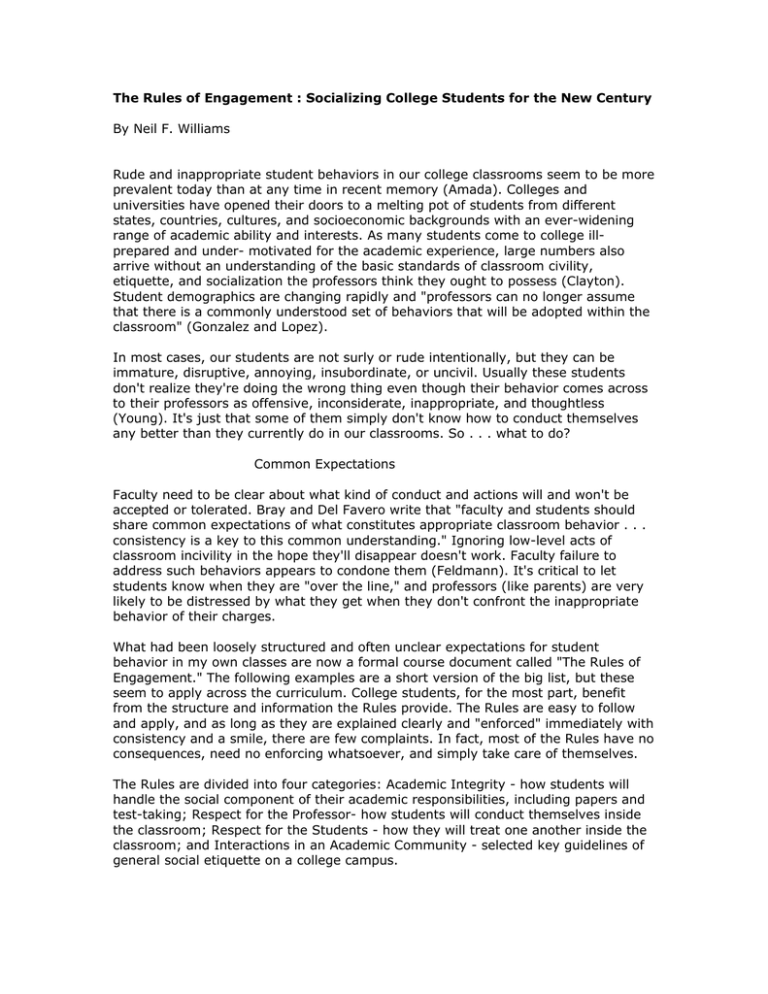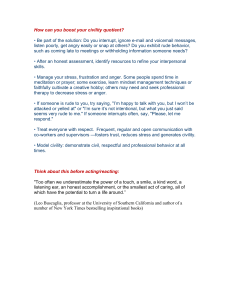The Rules of Engagement : Socializing College Students for the... By Neil F. Williams
advertisement

The Rules of Engagement : Socializing College Students for the New Century By Neil F. Williams Rude and inappropriate student behaviors in our college classrooms seem to be more prevalent today than at any time in recent memory (Amada). Colleges and universities have opened their doors to a melting pot of students from different states, countries, cultures, and socioeconomic backgrounds with an ever-widening range of academic ability and interests. As many students come to college illprepared and under- motivated for the academic experience, large numbers also arrive without an understanding of the basic standards of classroom civility, etiquette, and socialization the professors think they ought to possess (Clayton). Student demographics are changing rapidly and "professors can no longer assume that there is a commonly understood set of behaviors that will be adopted within the classroom" (Gonzalez and Lopez). In most cases, our students are not surly or rude intentionally, but they can be immature, disruptive, annoying, insubordinate, or uncivil. Usually these students don't realize they're doing the wrong thing even though their behavior comes across to their professors as offensive, inconsiderate, inappropriate, and thoughtless (Young). It's just that some of them simply don't know how to conduct themselves any better than they currently do in our classrooms. So . . . what to do? Common Expectations Faculty need to be clear about what kind of conduct and actions will and won't be accepted or tolerated. Bray and Del Favero write that "faculty and students should share common expectations of what constitutes appropriate classroom behavior . . . consistency is a key to this common understanding." Ignoring low-level acts of classroom incivility in the hope they'll disappear doesn't work. Faculty failure to address such behaviors appears to condone them (Feldmann). It's critical to let students know when they are "over the line," and professors (like parents) are very likely to be distressed by what they get when they don't confront the inappropriate behavior of their charges. What had been loosely structured and often unclear expectations for student behavior in my own classes are now a formal course document called "The Rules of Engagement." The following examples are a short version of the big list, but these seem to apply across the curriculum. College students, for the most part, benefit from the structure and information the Rules provide. The Rules are easy to follow and apply, and as long as they are explained clearly and "enforced" immediately with consistency and a smile, there are few complaints. In fact, most of the Rules have no consequences, need no enforcing whatsoever, and simply take care of themselves. The Rules are divided into four categories: Academic Integrity - how students will handle the social component of their academic responsibilities, including papers and test-taking; Respect for the Professor- how students will conduct themselves inside the classroom; Respect for the Students - how they will treat one another inside the classroom; and Interactions in an Academic Community - selected key guidelines of general social etiquette on a college campus. The following list includes samples from the four categories of the Rules of Engagement; they are not listed in any type of hierarchy of importance. They are intentionally written in an imperative style, and the italicized remarks are for the reader's convenience. Academic Integrity 1. When you turn a paper in late, place it in the professor's mailbox accompanied by a note from you indicating the exact time and date the paper was turned in. The time and date must also be validated with the signature of appropriate university personnel. This way, there is no question or doubt about the time and day the paper was turned in; the student has a witness and so does the professor. Students formally acknowledge the work was late and therefore accept any penalties the professor might assess per the course syllabus. 2. You will refrain from all negative test taking behaviors, including coughing, sniffing, nose- blowing, sighing, moaning, groaning, finger rapping, knee bouncing, foot tapping and other distracting activity. Exams are already stressful events and classmates have enough to worry about as they try to write their exams without having to hear, see, or feel someone's special set of quirks. Respect for the Professor 3. You and the professor will greet each other appropriately at the beginning and end of each class meeting. Every class meeting is an important event and the professor is the central person in the process. Since the professor will say "Hello" to the students, they should also return the "Hello," in a clear and audible voice, to start the day's proceedings. Similarly, as students exit the room at the end of the class, they should make eye contact and say something like "Thanks," or "'Bye, Dr. Williams." Dr. Williams will also say, "Good-bye," and appreciate your thoughtfulness. 4. You will remove hats and head- coverings PRIOR to entering the room at the start of a class and leave them off until you exit the room at the end of the meeting. The exceptions are head-coverings worn for religious or cultural reasons, but worshipping the Boston Red Sox or Green Bay Packers does not qualify here. 5. If you arrive late to class, please enter the room but wait at the door until you are invited to be seated. It is very impolite and inconsiderate to cross the room in front of or behind the professor while class is in progress, and latecomers will always be asked to join the group in short order. This is not done to embarrass anyone for being late; rather it is done to cause the smallest possible interruption to the teaching/learning process for professor and everyone else who somehow made it to class on time. 6. When you yawn, cover it completely with an entire hand. When the event has passed, mouth the words "Pardon me" or "Excuse me." An open-mouthed or uncovered yawn is about as insensitive, rude, and inappropriate as it gets. There is almost no instance in which a yawn arrives without some sort of internal biological warning, and all that is being asked is for students to cover their mouths out of respect for the person who is forced to look at them and their dental history. Respect for the Students 7. There is to be only one conversation at a time in class unless you are participating in group work or activities; when a student is talking to the class, all "eyes and ears" are on that individual. For some reason, when a student begins to talk by asking or answering a question, it is a signal to all of the other students to begin whispering to one another and to ignore the one who is speaking. The message this sends to the speaker is that her/his comments are worthless and unimportant; we can't have that in college. The spirit of academic life values everyone's opinions, ideas, and questions. Those opinions, ideas, and questions will command everyone's attention. Interactions in an Academic Community 9. When you have made an error in action or judgment, accept responsibility gracefully. This is not easy, especially when a printer doesn't work, all parking spots are taken, or a car breaks down. It does no good to try to spread or pass the blame to others; so doing makes you appear to be a person of poor character. Does it interrupt the flow of a class to ask a student to cover a yawn or remove a hat? Of course it does. How could it not be disruptive to the train of thought and pace of the presentation when the professor or students are distracted by some bit of grade school nonsense? But the negative behaviors diminish and disappear after a few weeks and the interruptions for infractions of the Rules become few and far between. Before there were Rules in my classes, student behaviors became increasingly distracting as the semester went on, and they were truly a detriment to the learning and teaching experience. Not any more. Civility Taught Now, courses run more smoothly and student behaviors go from annoying and unpleasant on "Day One" to appropriately considerate, polite, attentive, cooperative, and social by the end of the term. And it's easy, as long as everything is done with a smile. It is made clear at the outset that the Rules are in place not only so the course content can be taught, but also so that the students can become better people, better citizens, and eminently more employable or acceptable to graduate school. The Rules are a tangible way to show the students their professor cares about them and wants to help them. Our students gain a real benefit from knowing what they should and shouldn't do in public and academic settings. Rather than resent the structure imposed upon them, students embrace it. Instead of the end of social decorum in the college classroom, it is the beginning of a new civility. References * Amada, G.1999. Coping with Misconduct in the College Classroom: A Practical Model. Asheville, NC: College Administration Publications. * Bray, Nathaniel J., and M. Del Favero. 2004. "Sociological Explanations for Faculty and Student Classroom Incivilities." New Directions for Teaching & Learning, Fall, 2004, 99, 9-19. * Clayton, M. 2000. "Professors Struggle to Rout Out Rudeness." Christian Science Monitor, March 21, 2000, 92 (82), 16. * Colosimo, M. L. 2004. "How Shall We Learn? How Shall We Live?" Phi Kappa Phi Forum, Fall 2004, 84 (4), 32-33. * Feldmann, L. J. 2001. "Classroom Civility Is Another of Our Instructor Responsibilities." College Teaching, 49 (4), 137-140. * Gardner, M. 2002. "Will the 'Culture of Entitlement' Give Way to the Age of Humility?" Christian Science Monitor, March 6, 2002, 94 (70), 12. * Gonzalez, V., and E. Lopez. 2001. "The Age of Incivility: Countering Disruptive Behavior in the Classroom." AAHE Bulletin, 53 (8), 3-6. * Young, J. R. 2003. "Sssshhh. We're Taking Notes Here." Chronicle of Higher Education, 49 (48), A29. This article appeared on today's Tomorrow's Professor listserv, and appeared previously in The National Teaching & Learning Forum Newsletter, Volume 17, Number 1, December 2007©. Permission to put this article on the website was given by: Dr. Neil F. Williams Distinguished Professor Eastern Connecticut State University 83 High Street Willimantic, CT 06226 Telephone: (860) 465-5170 Fax: (860) 465-0186 E-mail: williamsn@easternct.edu For copyright information, contact Dr. Williams.

